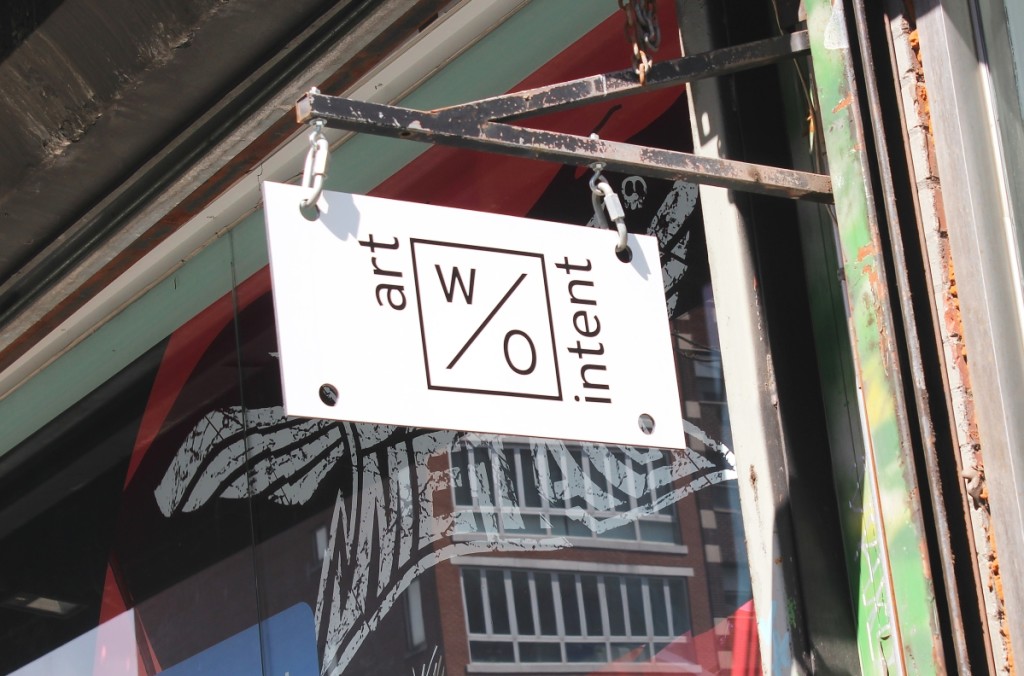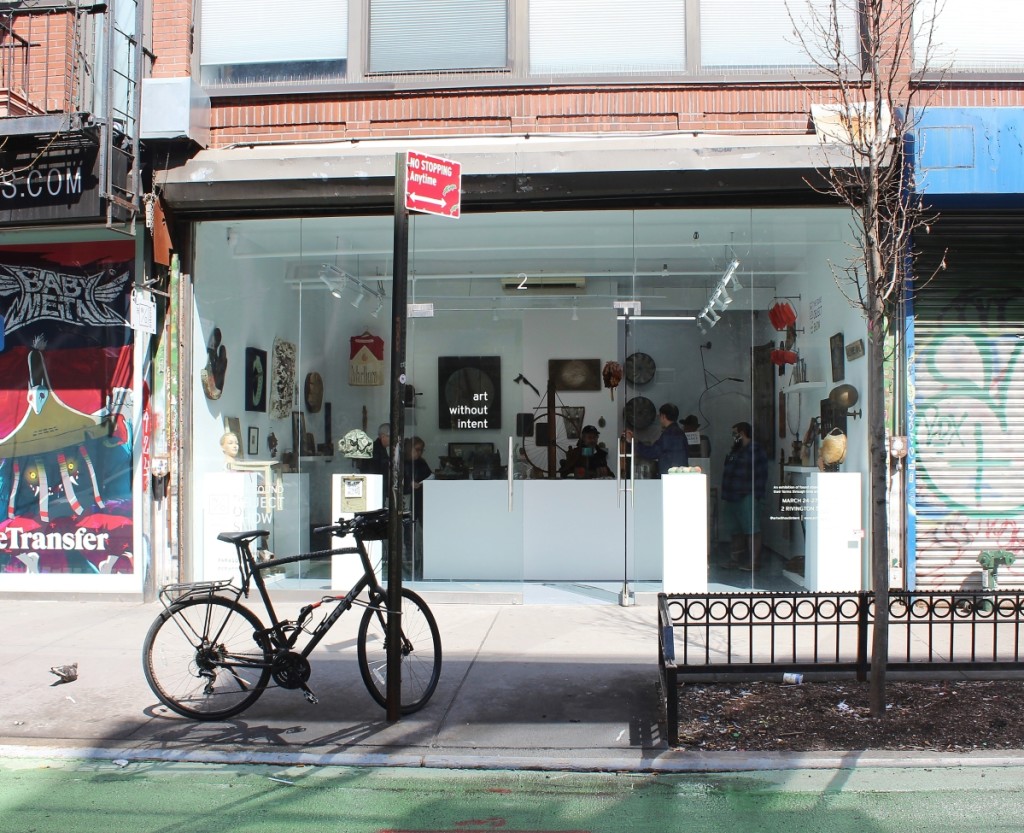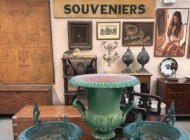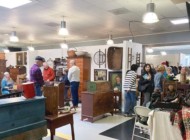Review & Onsite Photos By Madelia Hickman Ring, Catalog Photos Courtesy Exhibitors
NEW YORK CITY – What do a mossy softball, a trunk of animal skulls, a hot-pink clip-on bow tie with a braille label, a repaired Spode plate and a cluster of gun-sights from the Colt factory have in common? All were but a small part of the newest antiques shows in town. In a single-room gallery at 2 Rivington Street in Manhattan’s SOHO neighborhood on March 24-27, nine like-minded dealers mounted a new pop up antiques show that might change the preconception you ever had about antiques shows. At the very least, it may change the way you look at antiques again.
Titled “The Found Object Show: Art Without Intent,” the venture brought together a total of 96 objects in a variety of media. Booths were non-existent and pieces were presented as if in conversation with each other rather than grouped by dealer. Wall text or labels with prices listed were done away with and visitors were encouraged to look at the objects first before consulting the catalog or price list.
The show of only nine exhibitors was a largely collaborative effort, though Rhode Island dealer Adam Irish was instrumental in its conception and execution.
“Imagination is the essence of the Found Objects Show,” Irish says. “The entire endeavor was to hand over the objects to the eye of the beholder, wholly and fully.” He also defines “art without intent” as “the recognition of a found object triggers a wordless, intuitive, even involuntary aesthetic and conceptual response within the mind of its discoverer.”
That may take a few minutes to unpack.
Some of the objects were once commonplace but having lost their cultural context are now unfamiliar to Twenty-First Century eyes, like a mid- or late Nineteenth Century plumb bob (Stephen Powers), a wood and animal hide grain sifter (Joshua Lowenfels), a feather duster made from a variety of different-colored silk duster (Adam Irish), or a group of metal forms used for making balloons (Aarne Anton).
Unique pieces, purpose-made by unknown hands, abounded. These included a pair of altered eyeglass magnifiers from the 1930s (Ben Albucker); a scrapbook titled My Favorite Western Stars, made in October 1958 from lined pages within wooden boards by a boy named Jeffrey whose last name has been lost (Kevin Duffy); a pair of homemade barbells rendered from cement-filled coffee cans (Eric Oglander); a pair of handmade aluminum and fluorescent satin directionals from the mid-Twentieth Century (Janet West); and a handmade hardware storage bin, circa 1940s (Susan Wechsler).
As items age, the passage of time, or an item’s individual history, left an indelible mark as well. A bicycle seat encrusted with melted glass (Aarne Anton) that has been mounted on a stand becomes an abstract sculpture. The mossy softball, flattened on one end from having lain where it fell for decades, shows the physical weight of time (Ben Albucker), as does a diver’s helmet shrunken from being submerged at a great depth (Joshua Lowenfels). The sinuous curves of a glass bottle, acquired after it was in a fire, make it more interesting (Eric Oglander), while a decayed sculptograph of a man (Janet West) lends the subject an unusual appearance.
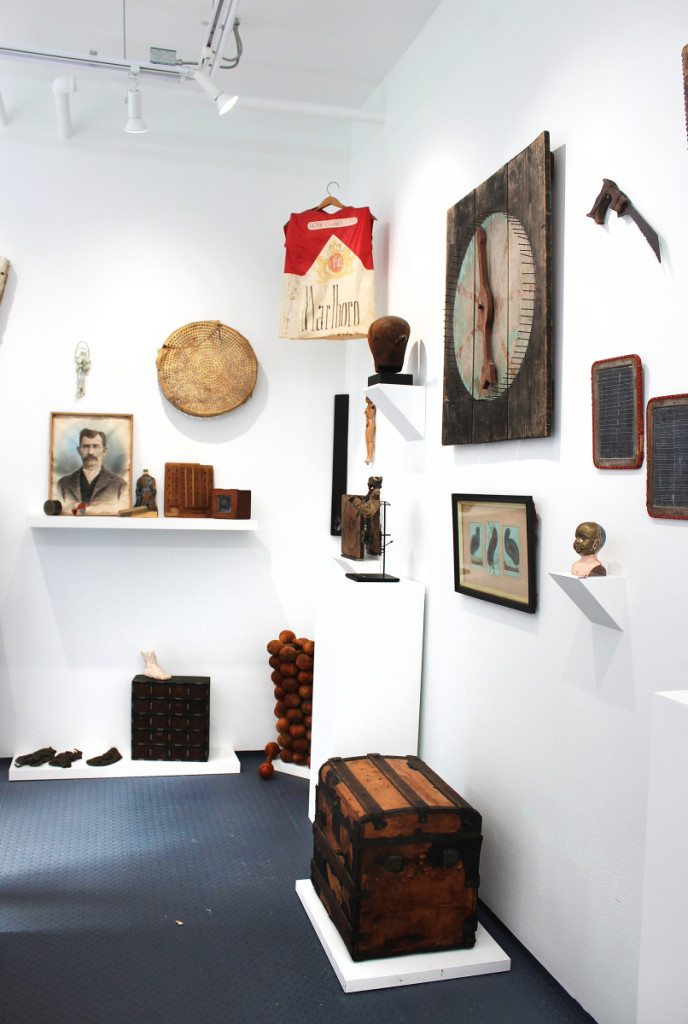
Items were spaced to both allow for an individual presentation but close enough to foster a dialogue between objects.
Some works provoked a visceral response. A wooden crate, upon first glimpse, appears to be fairly commonplace but lift the lid and you find yourself staring at an array of animal skulls discovered in upstate New York by Joshua Lowenfels. A leathery pillow on a plinth in the window invites further examination; upon reading the catalog, one discovers it is a petrified loaf of cheese in a rawhide pouch. A framed toilet seat with homemade electrodes begs more questions than anyone might want – or be able – to answer.
“There is a greatness in things that don’t claim that for themselves but can be found by others,” said Joshua Lowenfels, who was helping Irish staff the gallery over the weekend. “The normal signposts don’t exist in this show. It is a more challenging thing.”
In a traditional antiques shows, items in a booth are clearly labeled; viewers are told what they should know – and also believe – about the works in the booth. That format is useful for people who don’t have context or knowledge of historical background and can also further inform people who are in the know as to how best to contextualize a piece. Labels seek to establish where an object falls in the spectrum of material culture, how it is important and why it is assigned a specific value. This show puts forward the idea that as collectors and connoisseurs of “old things,” we have come to rely, perhaps too much, on those parameters.
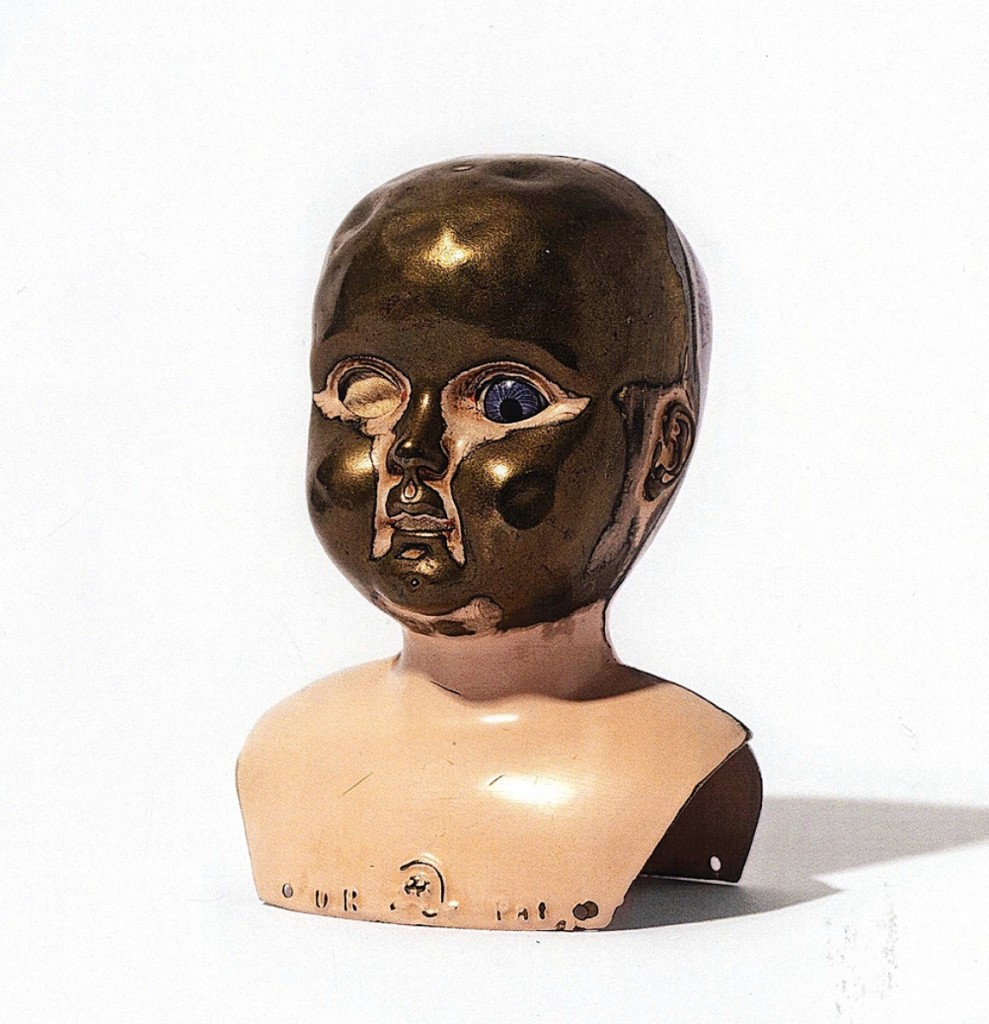
The surface of this metal doll head has been compulsively worn away by hand, suggesting one of its owners may have struggled with emotional issues and took comfort in stroking the head of a favorite toy. Eric Oglander.
The show published a beautiful catalog that identified each object and the dealer that was exhibiting it. In the introductory essay to the catalog he edited, Adam Irish describes found objects as “a thing without – without context, without category, without explanation, without creator and without a readymade definition.” One could also add “without influence:” viewers can look at things with fresh eyes. For collectors who are used to visiting an antiques shows and relying on labels for information, the show allows for a new way of engaging and interpreting things that is, frankly, refreshing and innovative. Viewers are given permission to create their own definitions of what is beautiful and has value.
Prices were available on a list, but the seeming intent of the show was to have visitors peruse the show and consider objects irrespective of value. For those that want to know, the least expensive item on display was with Adam Irish: a circa 1960s Feature matchbook of a tennis match – priced just below $100, while the most expensive piece on the list was a hinged salesman’s sample of a pig feed model that Steven Powers had priced at $4,200.
Halfway through the show, a large number of pieces had been sold, across all exhibitors and price points.
Exhibitors were pleased and uniformly positive in their feedback. “It was thrilling,” said Stanfordville, N.Y., art and antiques dealer Susan Wechsler. “One of the things I particularly liked was that all of our objects were shown together without any indication of ‘this is mine, that is yours,’ which presented a cohesive visual display as opposed to a traditional booth presentation. We all reviewed each other’s things, had Zoom calls, so it presented a very cohesive front.
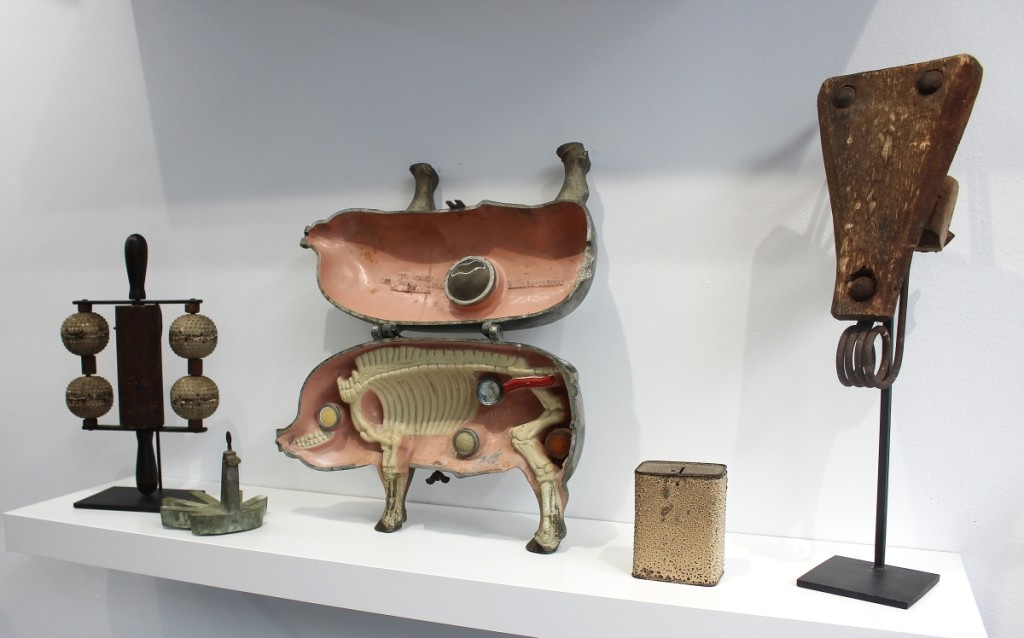
(L-R): Mounted massage rollers and an industrial mold (both with Susan Wechsler), a salesman’s sample pig feed model, circa 1924 (Steven Powers), a mounted Nineteenth Century wood and iron bicycle seat (Aarne Anton) and a painted tin bank with aged “alligatored” surface (Janet West).
“The graphic element is particularly interesting to me, as well as spatial relationships. Works that have an emotional punch, works that ask questions or that are mysterious but are recognizable as art. I’m also interested in things that are more unintentional or has inadvertent design or composition.”
Wechsler’s aesthetic was well represented in her pieces, which included a folky Chinese checkers board game that had a slightly askew design and showed accumulated paint loss, a pair of mounted factory gloves, and a double-sided painted wooden sign inscribed on one side, “Cut Rate Always.” She noticed that people who came to the show spent an unusually long time in the space, which she deemed “a testament to how interesting the show was.”
“The exhibit looked great, the glass storefront presence brought in so many curious and open eyes, people that had never thought of art and objects in this manner,” said Steven Powers. The New York City dealer “sold well to customers online and to new ‘walk-ins.’ The format of integrating our objects to serve the exhibit versus segregating our individual works was a key factor to the overall presentation.”
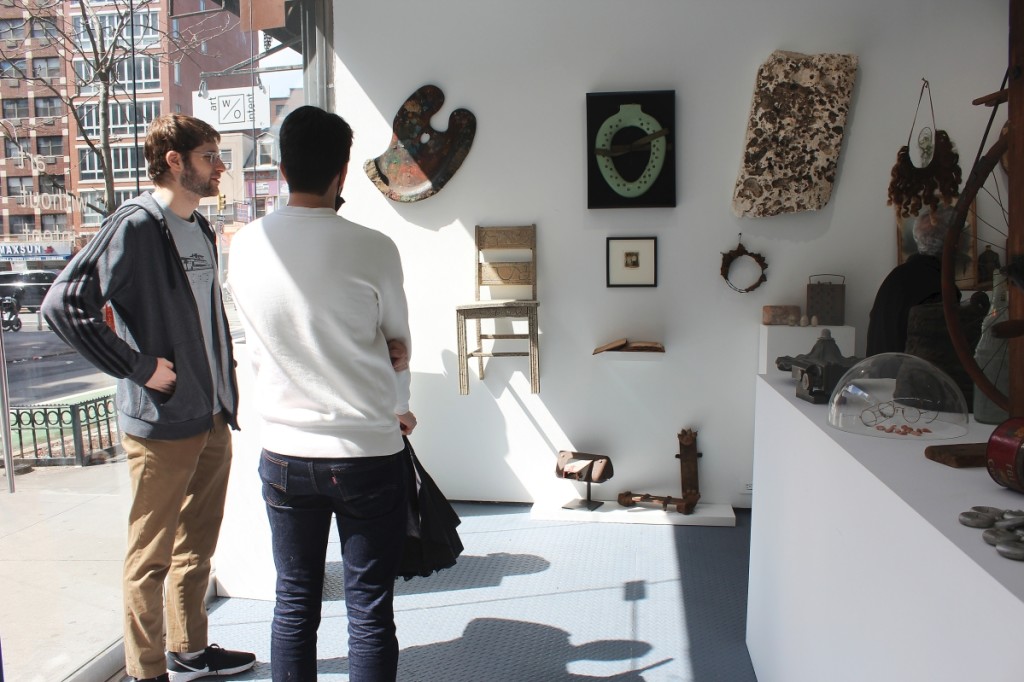
The gallery the show was in was well lit and provided visitors, if not a large space to look, a bright one.
Of similar mind was Aarne Anton, who said “it was so enjoyable participating in the Found Objects Show. As dealers of antiques and the visual arts, we have found ourselves drawn to objects of mystery and unconventional beauty. My motto has long been that if an object speaks to me and is fairly priced, there has to be at least one other person out there who responds as I do and wants to own it. Who knew that there were so many kindred spirits that would feel the same and come to a gallery show and buy? We all thought this was a more personal passion in finding the unconventional and presenting it as art. Not only are the objects shown difficult to define but each of the nine dealers brought surprising choices and perspective from their picking. My mind was spinning seeing how the show’s objects attracted or repelled each other to create the energy of the show that challenged conventions. My hat’s off to the dealers and to Adam Irish who conceived the show and pulled it all together.”
The Pomona, N.Y., dealer, promised to bring “some found objects shown [to] the Rhinebeck show where I and several dealers will bring other objects in a different context.”
“From the first moment I walked into the space, I was totally enchanted, recalled exhibitor Janet West. “I couldn’t help much with the set up, but clearly my help was not needed. All the other participants really gave it their all, turning that small storefront into a wondrous jewel box. [I] especially liked that everyone that walked by, became engaged. Even before it opened, people wanted to know WHEN it would open. It was such an interactive environment and [I] especially loved the large plinth, because the items on that seemed to play with each other and talk to the items on the walls and other plinths, everything invited comment.”
Will the show repeat itself in the future? Several of the exhibitors expressed that wish if the show can maintain the same relatively small scale and collaborative format.
For additional information, www.artwithoutintent.com.

